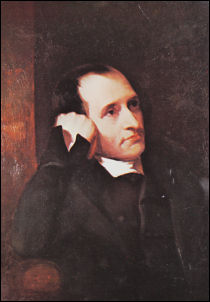|
Tue 09 Mar 2010
Life and Times of Samuel
Crompton by Donna Hughes. |
|
After missing
our January meeting due to be being snowbound Donna finally made
it, albeit with a cold. Her husband, Harry, scheduled to speak
at our March meeting did the decent thing and stepped aside for
her.
Donna last visited us in January 2009 with her talk on the
History of Spinning and Weaving.
Samuel Crompton was born in December 1753 into a very poor
family in Firwood Fold, Bolton.
In 1758 the family moved into Hall iíthí Wood where his father
was caretaker. Unfortunately, he died aged 32 and Betty, his
widow, was left to bring up Samuel and his siblings. |

Donna demonstrating how to 'card' the wool. |

Samuel Crompton (1753 - 1827) |
Samuel could
spin on a spinning wheel by aged 5. Aged 7 he was sent to school
to learn to read and learn trigonometry. He was also sent to a
master weaver to learn that craft.
At that time the weaving process was time consuming but changes
were happening. James Hargreaves had invented the spinning
jenny, which Samuel worked on it but didnít like it. Wool or
flax was worked but cotton had started to be imported.
Samuel set himself to work on how to improve the jenny so making
it able to produce a fine strong cotton yarn.
It took him 10 years to develop, 5 years to think, 5 years to
build.
His machine had 48 spindles and produced excellent cotton yarn,
which sold for a good price at Bolton market. Unfortunately he
couldnít afford the patent. |
|
He charged
people to view the machine in 1780 and 53 individuals agreed to
pay £70. However, he actually received £60. The subscription
list revealed many people who went and made their fortune and
fame in the mills.
His machine was wrecked at the hands of the Luddites and moved
because of the trouble. He continued improving the machinery by
adding more spindles on his mule.
Samuel was a great inventor and innovator but a bad businessman.
Robert Peel visited and offered money for his mule but was
turned down. He lost his apprentices to others that paid more.
In 1810, aged 50, he was desperate but failed in his petition
for money. In stark contrast £40m worth of cotton was spun on
mules that employed 70,000 people. |

Part of Donna's display |

The only surviving example of a spinning mule
built by Samuel Crompton
|
By 1812 another
petition for money was made to government on his behalf by
people that included some who had benefited from his mule.
Unfortunately, Spencer Percival, who was to read his petition on
11 May 1812, was shot dead. |
|
Samuel was
finally awarded just £5,000 for a life-time of invention and
innovation that benefited not just individuals but the country
as a whole.
Sadly he died, aged 73, with more debts than assets.
Belatedly, Bolton council recognized his importance by erecting
a statue to him in the town in 1862. |

Hall i' th' Wood manor house,
a former home of Samuel Crompton |